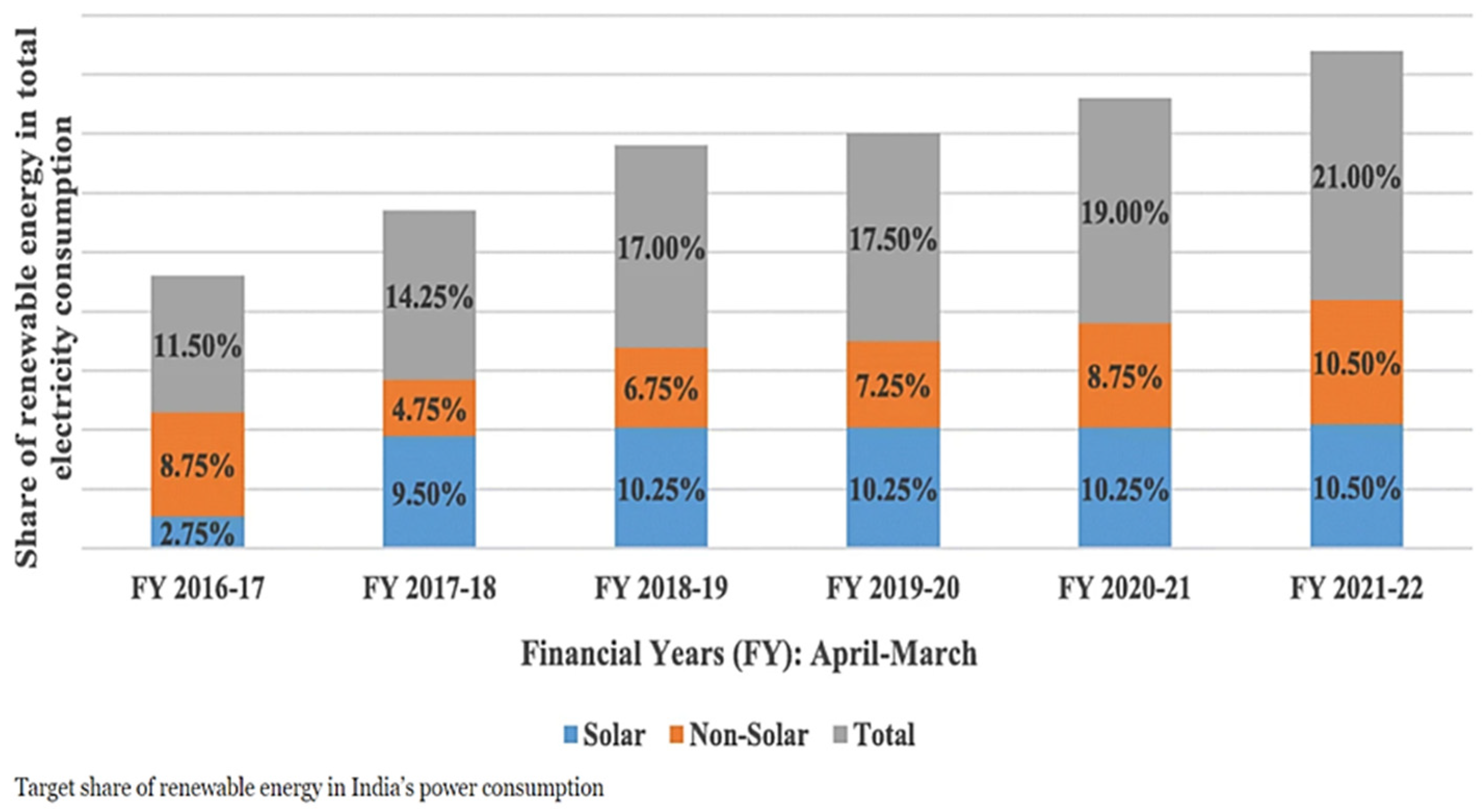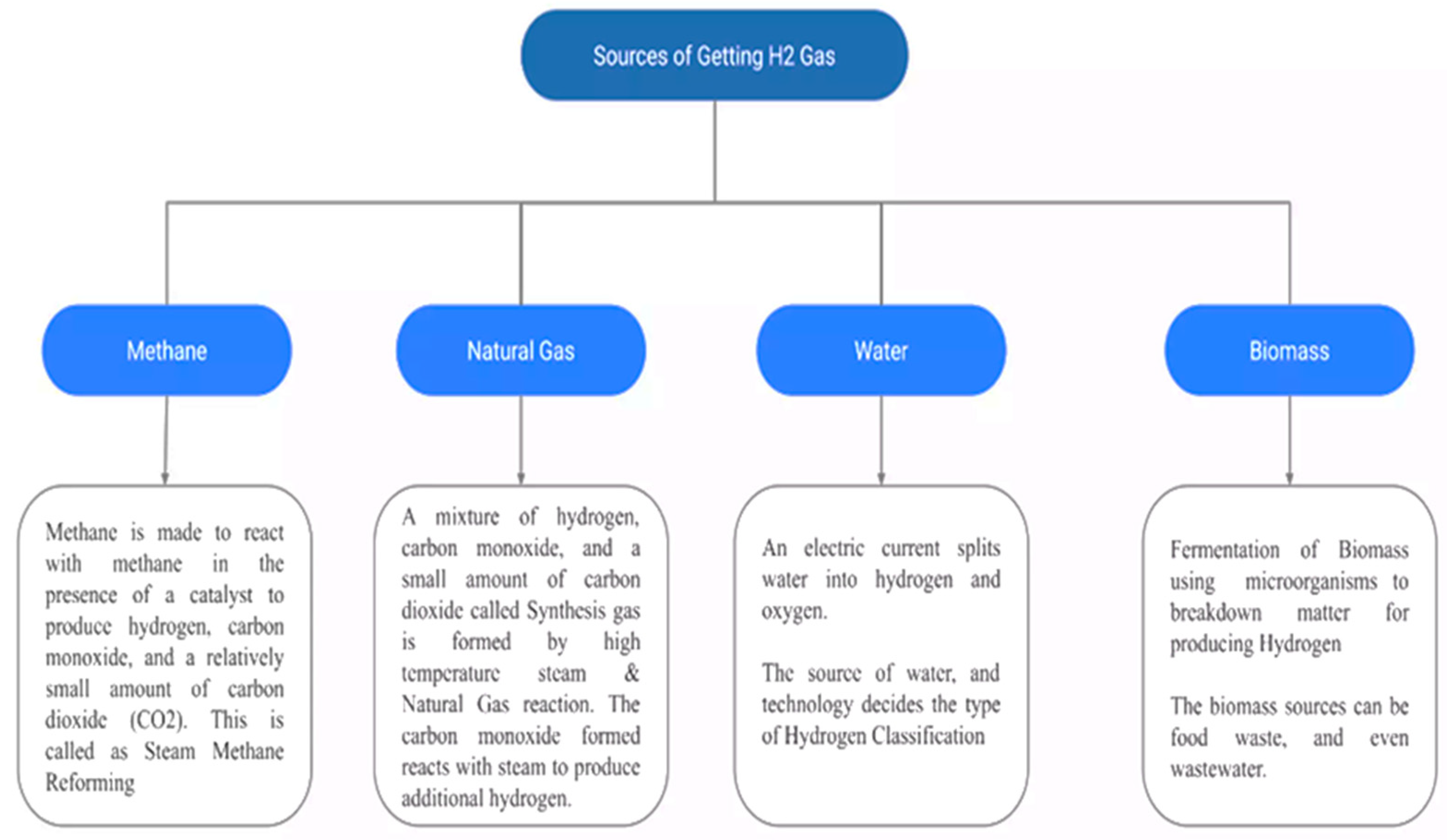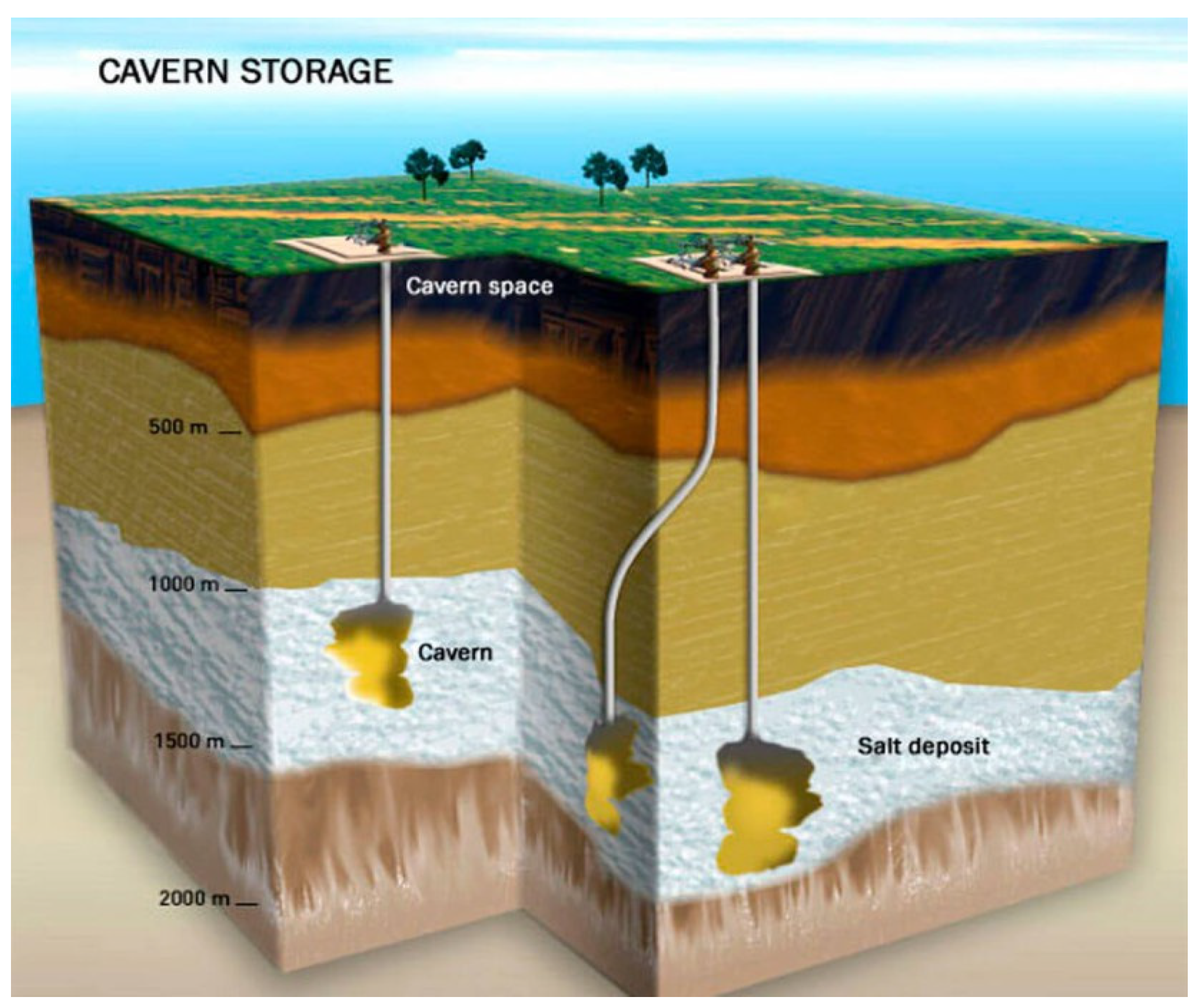Green Hydrogen as a Clean Energy Resource and Its Applications as an Engine Fuel †
Abstract
1. Introduction
2. Hydrogen Production and Storage
2.1. Types of Hydrogen
- Grey Hydrogen: When hydrogen is synthesised from fossil fuels like natural gas, it is called grey hydrogen. During the process of making hydrogen, carbon dioxide is released, which is not captured. It is the most commonly available form of hydrogen.
- Blue Hydrogen: Blue hydrogen is produced by the same process as grey and from fossil fuels only, except that the carbon produced is captured here and stored.
- Green Hydrogen: The mostly sought-after form of hydrogen is green hydrogen, which utilises green energy or renewable energy for producing hydrogen. It is generally performed via the electrolysis of water using renewable energy.
2.2. Production of Hydrogen
- Steam Methane Reforming (SMR) technique: In this technique, methane produced from natural gas is allowed to heat in the presence of steam, generally in the presence of a catalyst, leading to the production of carbon monoxide and hydrogen and a very minute amount of carbon dioxide.
- Natural Gas Reforming: In this process, a mixture of gases containing hydrogen, carbon monoxide and a very small amount of carbon dioxide, i.e., synthesis gas, is produced by a reaction between high-temperature steam and natural gas. The carbon monoxide that is released further reacts with steam to produce surplus hydrogen.
- Electrolysis of water: An electric current is employed to split water into its constituents’ releasing hydrogen and oxygen. If renewable sources of electricity (like solar or wind) are used, the so-produced hydrogen is considered renewable as well, and have several benefits in emissions.
- Biomass conversion: The conversion of biomass into sugar-rich feedstocks is carried out, followed by fermentation in the presence of microorganisms to produce hydrogen. The sources of biomass can be food waste, crop residues, sewage residues, animal residues, or even wastewater [9].
2.3. Storage of Hydrogen
- Low volumetric energy density: As the simplest element with a very low weight and a very low boiling point, i.e., −253 °C, hydrogen tends to be easily lost in the environment.
- Embrittlement of metal cylinders: Storing hydrogen in its compressed form in metal cylinders is a general practice; however, hydrogen causes the embrittlement of metal cylinders and thus deteriorates the metal surface and is therefore an important safety concern.
- Geological hydrogen storage: A considerably viable solution is to store hydrogen inside the porous rocks in the salt caverns or salt domes wherein it remains in the combined state. Figure 3 shows the salt caverns used for hydrogen storage.
- Compressed hydrogen storage: The storage of hydrogen in the compressed state typically requires a very high pressure ranging from 350 to 700 bar and cryogenic temperatures.
- Liquid hydrogen: Hydrogen can be liquified by lowering its temperature to −253 °C and can be stored in cryogenic tanks.
- Material-based storage: Distinct storage techniques are adopted by combining hydrogen with distinct materials. Combining hydrogen with adsorbent materials, e.g., palladium, which has the capacity to adsorb 900 times of hydrogen than its own volume. Some other alloys, such as those of magnesium and aluminium, can be employed to serve the purpose. Another way involves the usage of ammonia gas as a hydrogen carrier, which can be desirably cracked as per H2 requirements [8].
2.4. Benefits of Hydrogen as Fuel
- Infinite Supply: An unlimited amount of hydrogen gas can be produced by the electrolysis of water, which, upon combustion, again yields water; thus, there will be no constraint of hydrogen supply ever.
- High Calorific Value: Hydrogen has a very high heating value of 120 MJ/kg compared to 45 MJ/kg for CNG, suggesting that the mass flow rate of hydrogen supplied to the engine will be much lesser and hence the storage requirements will decrease.
- No Carbon Emissions: The carbon footprint is drastically lower for green hydrogen as compared to fossil fuels. Although the hydrogen-to-carbon ratio varies slightly depending on the type of crude oil, generally, gasoline and diesel contain approximately 84 to 86 wt-% of carbon and 14 wt-% of hydrogen, while there is no carbon content in hydrogen. It helps address one of the vital concerns of environmentalists, which is global warming due to fossil fuels GHG emissions.
- Aviation fuel: Liquified hydrogen gas has a huge potential to be used as a potential aviation fuel also and a lot of active research is going on in this domain.
2.5. Prospects of Green Hydrogen
3. Literature Review
Based on Its Use as Engine Fuel
4. Conclusions
Author Contributions
Funding
Institutional Review Board Statement
Informed Consent Statement
Data Availability Statement
Conflicts of Interest
References
- Khan, I.; Fujun, H.; Hoang, P.L. The impact of natural resources, energy consumption, and population growth on environmental quality: Fresh evidence from the United States of America. Sci. Total Environ. 2021, 754, 142222. [Google Scholar] [CrossRef] [PubMed]
- Taneja, S.; Parmar, A. Analysis of the engine characteristics of a variable compression ratio SI engine fuelled with various gasoline-ethanol blends. AIP Conf. Proc. 2019, 2148, 030056. [Google Scholar] [CrossRef]
- Mehrjerdi, H. Modeling and optimization of an island water-energy nexus powered by a hybrid solar-wind renewable system. Energy 2020, 197, 117217. [Google Scholar] [CrossRef]
- Sitharthan, R.; Swaminathan, J.N.; Parthasarathy, T. Exploration of wind energy in India: A short review. In Proceedings of the National Power Engineering Conference (NPEC), Madurai, India, 9–10 March 2018; IEEE: Piscataway, NJ, USA, 2018. [Google Scholar]
- Kumar, C.M.S. Solar energy: A promising renewable source for meeting energy demand in Indian agriculture applications. Sustain. Energy Technol. Assess. 2023, 55, 102905. [Google Scholar] [CrossRef]
- Kumar, J.; Majid, M. Renewable energy for sustainable development in India: Current status, future prospects, challenges, employment, and investment opportunities. Energy Sustain. Soc. 2020, 10, 2. [Google Scholar] [CrossRef]
- Olabi, A.G. Renewable energy and energy storage systems. Energy 2017, 136, 1–6. [Google Scholar] [CrossRef]
- Muhammed, N.S.; Haq, B.; Shehri, D.A.; Zaman, E. A review on underground hydrogen storage: Insight into geological sites, influencing factors and future outlook. Energy Rep. 2022, 8, 461–469. [Google Scholar] [CrossRef]
- Ayodele, T.R.; Josiah, L.M. The potential role of green hydrogen production in the South Africa energy mix. J. Renew. Sustain. Energy 2019, 11, 044301. [Google Scholar] [CrossRef]
- Bongartz, D.; Doré, L.; Eichler, K.; Grube, T.; Heuser, B.; Laura, E.H.; Robinius, M.; Pischinger, S.; Walther, G.; Mitsos, A. Comparison of light-duty transportation fuels produced from renewable hydrogen and green carbon dioxide. Appl. Energy 2018, 231, 757–767. [Google Scholar] [CrossRef]
- Becerra-Ruiz, J.D.; Gonzalez-Huerta, R.G.; Gracida, J.; Amaro-Reyes, A.; Macias-Bobadilla, G. Using green-hydrogen and bioethanol fuels in internal combustion engines to reduce emissions. Int. J. Hydrogen Energy 2019, 44, 12324–12332. [Google Scholar] [CrossRef]
- Atilhan, S.; Park, S.; El-Halwagi, M.M.; Atilhan, M.; Moore, M.; Nielsen, R.B. Green hydrogen as an alternative fuel for the shipping industry. Curr. Opin. Chem. Eng. 2021, 31, 100668. [Google Scholar] [CrossRef]
- Shadidi, B.; Najafi, G.; Yusaf, T. A Review of Hydrogen as a Fuel in Internal Combustion Engines. Energies 2021, 14, 6209. [Google Scholar] [CrossRef]
- Teoh, Y.H.; How, H.G.; Le, T.D.; Nguyen, H.T.; Loo, D.L.; Rashid, T.; Sher, F. A review on production and implementation of hydrogen as a green fuel in internal combustion engines. Fuel 2023, 333, 126525. [Google Scholar] [CrossRef]
- Jie, S.; Zhu, Y.; Feng, Y.; Yang, J.; Xia, C. A Prompt Decarbonization Pathway for Shipping: Green Hydrogen, Ammonia, and Methanol Production and Utilization in Marine Engines. Atmosphere 2023, 14, 584. [Google Scholar] [CrossRef]



| Gasoline | Ethanol | |
|---|---|---|
| Chemical formula | C2–C14 | C2H6OH |
| H/C ratio | 1.795 | 3 |
| O/C ratio | 00 | 0.5 |
| Oxygen content (%) | 00 | 34.7 |
| Research octane number | 95 | 106 |
| Stoichiometric air–fuel ratio | 15:1 | 9:1 |
| LHV (MJ/kg) | 43 | 27 |
| Density@20 °C (kg/m3) | 744.6 | 791 |
Disclaimer/Publisher’s Note: The statements, opinions and data contained in all publications are solely those of the individual author(s) and contributor(s) and not of MDPI and/or the editor(s). MDPI and/or the editor(s) disclaim responsibility for any injury to people or property resulting from any ideas, methods, instructions or products referred to in the content. |
© 2024 by the authors. Licensee MDPI, Basel, Switzerland. This article is an open access article distributed under the terms and conditions of the Creative Commons Attribution (CC BY) license (https://creativecommons.org/licenses/by/4.0/).
Share and Cite
Taneja, S.; Jain, A.; Bhadoriya, Y. Green Hydrogen as a Clean Energy Resource and Its Applications as an Engine Fuel. Eng. Proc. 2023, 59, 159. https://doi.org/10.3390/engproc2023059159
Taneja S, Jain A, Bhadoriya Y. Green Hydrogen as a Clean Energy Resource and Its Applications as an Engine Fuel. Engineering Proceedings. 2023; 59(1):159. https://doi.org/10.3390/engproc2023059159
Chicago/Turabian StyleTaneja, Sumit, Ankur Jain, and Yash Bhadoriya. 2023. "Green Hydrogen as a Clean Energy Resource and Its Applications as an Engine Fuel" Engineering Proceedings 59, no. 1: 159. https://doi.org/10.3390/engproc2023059159
APA StyleTaneja, S., Jain, A., & Bhadoriya, Y. (2023). Green Hydrogen as a Clean Energy Resource and Its Applications as an Engine Fuel. Engineering Proceedings, 59(1), 159. https://doi.org/10.3390/engproc2023059159





